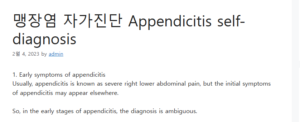1. Early symptoms of appendicitis
Usually, appendicitis is known as severe right lower abdominal pain, but the initial symptoms of appendicitis may appear elsewhere.
So, in the early stages of appendicitis, the diagnosis is ambiguous.

Early symptoms of appendicitis include:
1) Subtle pain around the navel
2) It is disgusting and disgusting.
3) no appetite
4) Intestinal discomfort and constipation
5) Pain comes and goes, then changes
※ These symptoms may last for 2-3 days.
In particular, the elderly are less sensitive to pain, so they may complain of vague digestive discomfort or feel weaker pain, so they need to be more careful around them.
Afterwards, pain around the navel to lower abdomen tends to move to right lower abdominal pain. 맹장염 자가진단
Characteristics of early symptoms of appendicitis
It starts with subtle pain around the belly button. 좋은뉴스
Pain location and symptoms change
Diagnosis is vague.
2. Appendicitis symptoms, appendicitis symptoms
appendicitis = appendicitis
The appendix is located at the beginning of the large intestine, and the process at the end of the appendix is the appendix.
Appendicitis Symptoms (Appendicitis Symptoms)
The most common symptom of appendicitis is right lower abdominal pain (more than 95%).
Anorexia, nausea, vomiting (80%)
Abdominal tenderness, fever, constipation, diarrhea
If the appendix is on the right side, pain in the right side occurs
If the appendix is located in the pelvis, discomfort above the pubic bone occurs
The characteristic symptoms of appendicitis are
I feel a lot of pain when I press my right lower abdomen and then suddenly release my hand.
The pain may also increase when walking or coughing.
You may also feel back pain.
Symptoms of appendicitis include diarrhea, frequent urination, and vomiting.
If it gets worse, high fever, pain throughout the abdomen. Rapid heart rate, etc. may appear.
Pain varies greatly from person to person.
Diagnosis can be difficult when appendicitis does not have these typical symptoms.
If the appendix bursts and becomes peritonitis, it is very dangerous, so please visit the hospital for treatment in the early stages of appendicitis symptoms.
3. Female appendix position
The location of the appendix in men and women is the right lower abdomen.
In pregnant women, the appendix may be pushed toward the right upper abdomen, so you may feel pain in the right upper abdomen.
Male and female appendix location: If the appendix is located below the pelvis, discomfort may occur above the pubic bone.
If the appendix is tilted to the right side, right flank pain may occur.
The appendix is located about 1/3 of the line connecting the pelvic bone protruding from the right lower abdomen and the navel.
Depending on the person, the location of the appendix may vary slightly, and the location may change if the appendix is inflamed and swollen.
4. Appendicitis causes
Appendicitis The cause of appendicitis is an overgrowth of lymphoid tissue (usually in the teens) or blockage of the appendix by stool.
When the appendix becomes blocked, it becomes inflamed and bacteria multiply, causing the appendix to swell.
Appendicitis commonly occurs between the ages of 10 and 30. It can occur at any other age. (occurs about 7% of the total)
5. Self-diagnosis of appendicitis appendicitis
1) Lie down in a comfortable position and raise both knees.
2) If there is pain when the right lower abdomen is pressed, appendicitis can be suspected.
The key to self-diagnosis of appendicitis is to check if it hurts when you press it and if the pain gets worse when you press and release it.
※ Please note that pressing with too much intensity or too often can be dangerous due to stimulation.
☆ If you have symptoms of acute appendicitis, you should seek medical attention as soon as possible.
If you delay, your appendix could rupture and be dangerous.
6. Other conditions similar to appendicitis pain
1) ectopic pregnancy
Left and right lower abdominal pain, abdominal pain and shoulder pain with intra-abdominal bleeding
2) Diseases of the uterus and ovaries, menstrual pain, ovulation pain, pelvic inflammatory disease
3) ascending tubercle
4) diverticulitis, cholecystitis
5) Mesenteric inflammation (mainly in 10s to 20s)
We looked at abnormal symptoms of appendicitis, location of the appendix in men and women, symptoms of appendicitis, and self-diagnosis of appendicitis.